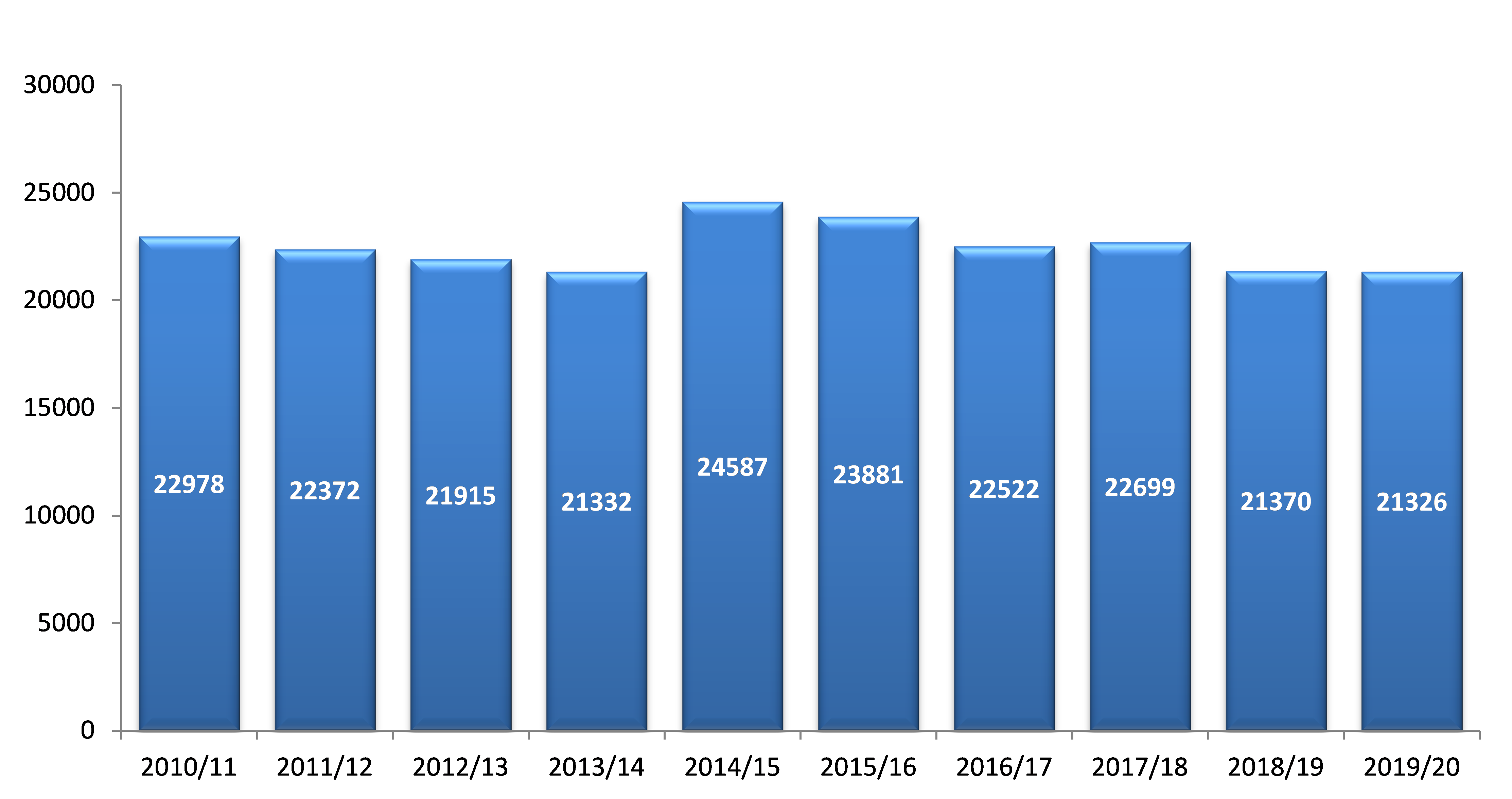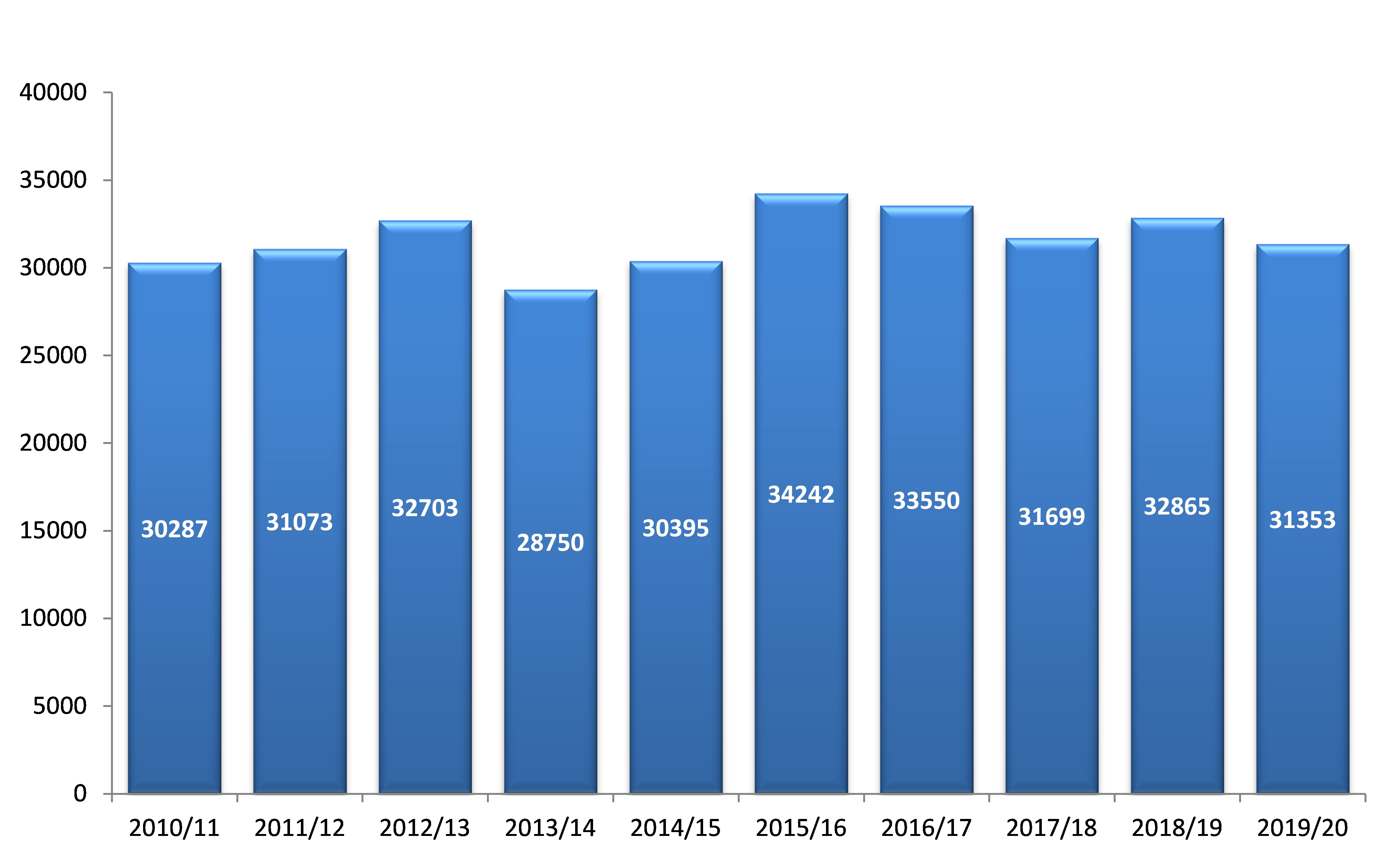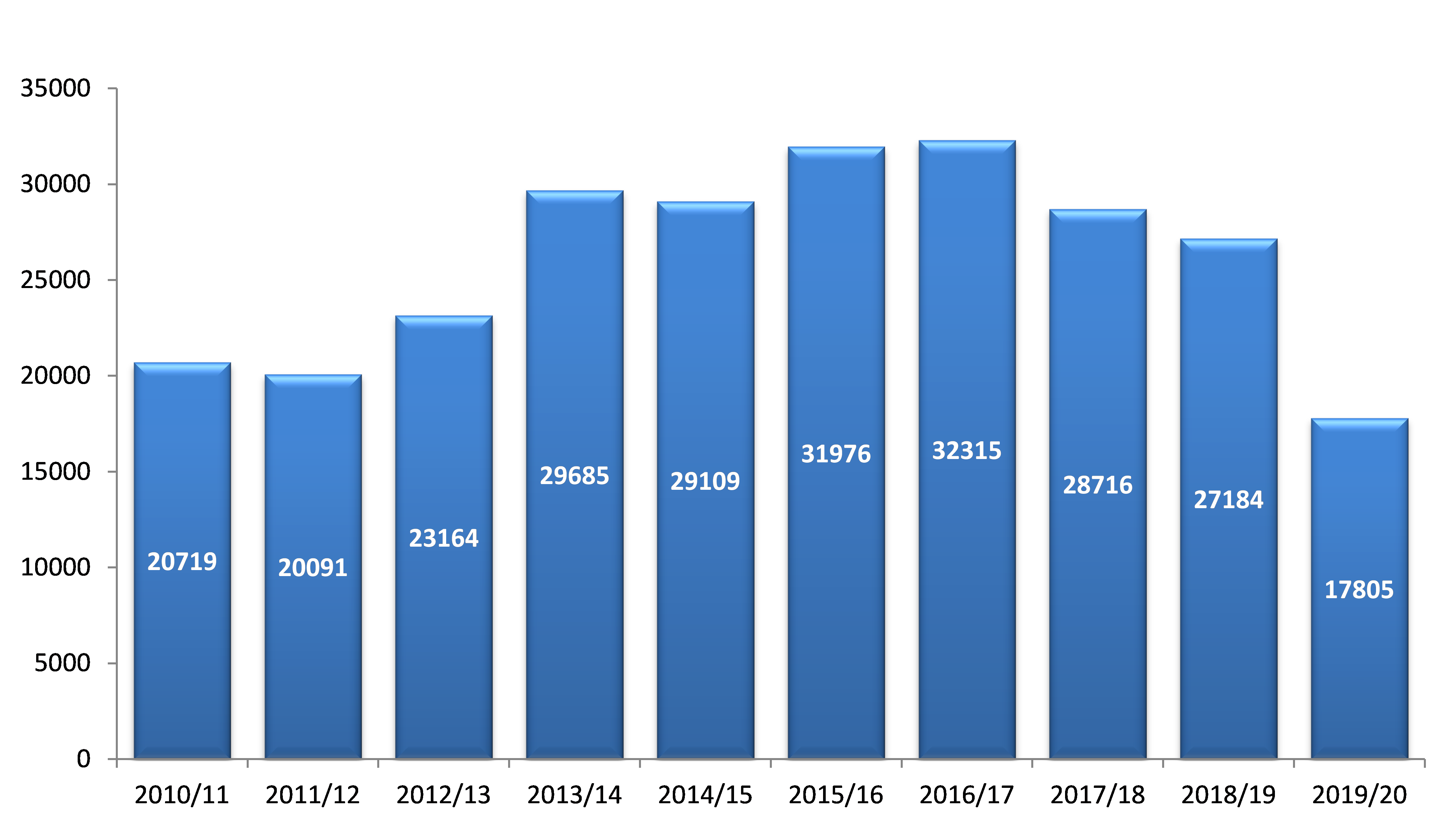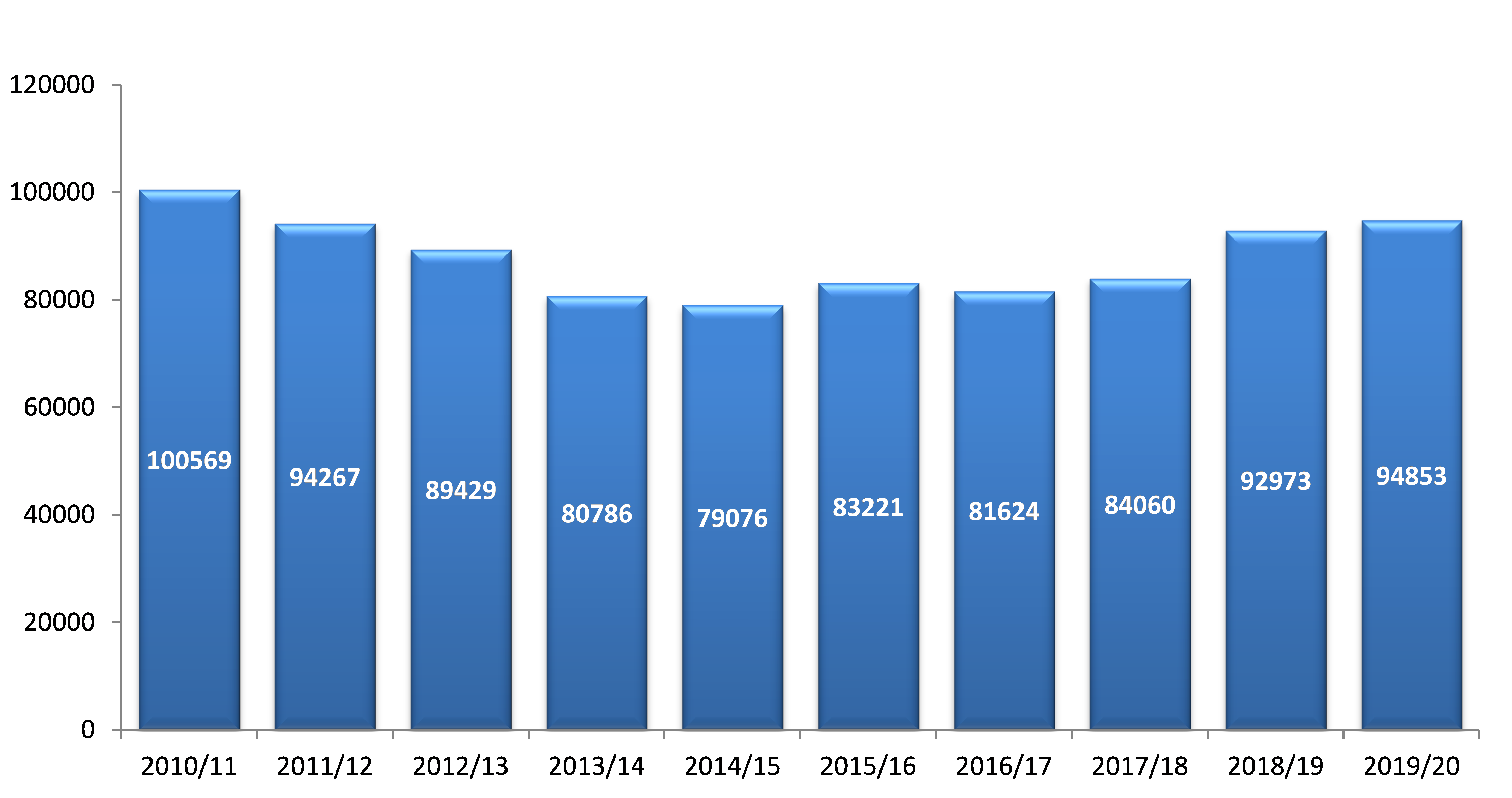Annual report 2019-20 - Agency's performance
Performance at a glance
In February 2020 the first cases of COVID-19 were confirmed in South Australia with the Department of Health and Wellbeing (DHW), as the Control Agency under the State Emergency Management Plan, declaring COVID-19 to be a Public Health Emergency. SAPOL began preparation for the potential significant operational impact of the pandemic and on 16 March 2020 the Police Commissioner activated the Police Operations Centre to manage the state policing response to COVID-19.
On 22 March 2020 the Police Commissioner as State Coordinator under the Emergency Management Act 2004, declared a Major Emergency, extended by the Governor six times until September 2020. Past declarations under the Act have never been extended beyond four days.
From March 2020, SAPOL under the direction of the Commissioner as State Coordinator, has successfully provided an effective public safety response to the COVID-19 emergency, which continues to have a significant impact on many facets of community life.
The policing response has many dimensions. It covers setting enforceable general directions as necessary to all persons in South Australia, on issues such as isolation and quarantine requirements, border controls, and restrictions to public activities and gatherings. Directions are made in consultation with DHW and are regularly reviewed and amended to reflect changing conditions. Directions are available at https://www.legislation.sa.gov.au/Web/Information/CV19/CV19.aspx.
SAPOL’s resource commitment to COVID-19 has been, and will continue to be significant, with around 500 police staff involved in 24/7 operations across the State, centrally managed from the Police Operations Centre.
Other demands for policing services throughout the year resulted in an increase in telephone calls for police assistance at the Call Centre (572 486) and Triple Zero calls (179 890). This was an additional 4.5% or 24 644 in call centre calls and 7.9% or 13 118 Triple Zero calls from the previous year.
Over the 10 year period from financial year 2010-11 to 2019-20 there has been a steady reduction in overall recorded crime resulting in a decrease of 6.0% or 7 368 offences (123 547 to 116 179) for total offences against person and property in
2019-20.
Crime trends are subject to fluctuation, and from 2018-19 to 2019-20, there was an increase in overall recorded crime of 1.6% or 1 836 offences from 114 343 to 116 179 (refer to crime trends on pages 19-23).
There were also less people arrested and reported this year (30 779 down from 56 706). SAPOL processed over 30 000 prisoners through our holding facilities.
Some key examples of policing work throughout the year are:
SAPOL continued to work in effective crime prevention and detection partnership with the Australian Federal Police through the Joint Anti-Child Exploitation Team (JACET); to pursue offenders exploiting children online. In 2019-20, JACET conducted 129 investigations resulting in 89 arrests and 52 children saved.
Illicit drug manufacture, distribution and use, remain a driver of both criminal and antisocial behaviour. In 2019-20 SAPOL issued 6 740 cannabis expiation notices, seized around 14 kilograms of methamphetamine, 12 553 cannabis plants, 597 grams of heroin and 216 377 litres of fantasy; as well as located/dismantled 64 clandestine laboratories.
In 2019 in response to a number of violent robberies in gaming venues where the offenders were armed and patrons and/or gaming room staff were seriously injured, SAPOL conducted Operation Foil. The Serious Crime Task Force worked closely with the Australian Hotels Association establishing a U-Witness-It website allowing free flowing information exchange between the community and SAPOL. Patrols were actively deployed to provide an overt presence in the hot spot locations, preventing several robberies. This operation resulted in 28 arrests and reports, 109 premises searched, 165 traffic offences/contacts and seizures of methamphetamine, cannabis, firearms and stolen property.
Road safety also continued to be a key focus of police activity. This year SAPOL conducted over 406 000 alcohol and 41 000 drug roadside screening tests across the State resulting in over 4 600 alcohol and 6 200 drug detections.
There were 103 lives lost, 802 serious injuries and 5 471 casualty crashes in 2019-20 on South Australian roads. In this period, SAPOL issued 163 156 traffic expiation notices.
As part of reducing road trauma and making South Australian roads safe for all road users, in 2019-20 SAPOL conducted 44 corporate/state-wide traffic operations targeting the fatal five (drink and drug driving, speeding, distraction, seatbelts and dangerous road users).
In August 2019 SAPOL launched a new operation called Operation High Impact F5. This operation targeted all of the fatal five offences of drink and drug driving, speeding, distraction, seatbelts and dangerous road users. The main purpose of this operation was to reinforce the message that any person using South Australian roads must be totally accountable and responsible for their behaviour, as taking unnecessary risks or making bad decisions can have lifelong devastating consequences. High Impact results included 145 290 drink driving tests with 1 155 detections, 8 870 drug driving tests with 963 detections, other detections were 12 417 for speeding, 1 696 for distraction and 978 for seatbelts, with 896 vehicles impounded.
On 3 October 2019 SAPOL launched the new Traffic Watch App to the South Australian community. The app allows members of the public with access to a mobile phone or computer to easily report traffic related complaints. These complaints are used in the development of an appropriate road safety enforcement response by determining the future allocation of resources and identifying locations for drug and alcohol testing.
In December 2019 SAPOL commenced a trial of eTicketing, which allows for expiation notices to be issued by email and post. Due to the positive response to the new system, on 16 June 2020 eTicketing was rolled out to all SAPOL members in a phased approach. The new eTicketing technology will eventually supersede handwritten paper notices and provide members of the public with the option of receiving an expiation notice either by email, post or print. The new system will enable police officers to enter expiation notices directly into Mobile Ruggedised Tablets (MRTs) and desktop computers for all expiable offences and cautions including traffic, controlled substances, liquor licencing, public transport and environmental protection.
SAPOL also continued to educate the South Australian community on safer road use practices and road safety awareness by delivering 745 road safety sessions attended by over 42 000 people.
As above, community engagement through information sharing and collaboration in problem solving is an intrinsic part of policing. During 2019-20, SAPOL held three Police and Community (PACE) and five PACE Facebook forums discussing rail and road safety, heavy vehicles, vehicle crime and, home and bicycle security, with approximately 137 000 people reached on line.
SAPOL’s Year at a Glance can be found at: https://www.police.sa.gov.au.
Agency contribution to whole of Government objectives
Key objective | Agency’s contribution |
Better Services | Counter Terrorism
Protecting our police
Hoon hotline
Reduce red tape
|
Agency specific objectives and performance
Public Safety | Level of Community Confidence in policing services. | 84.9%, above the national average |
Percentage of Grade 1 taskings in the metropolitan area responded within 15 minutes. | 95.4%, above the target of ≥80.0% | |
Number of calls received by Call Centre. | 572 486 | |
Number of 000 calls presented to Police Communications Centre by Telstra. | 179 890 | |
Crime and Criminal Justice Services | Number of recorded offences against the person as reported by/on behalf of victims per 1000 head of population. | 12.17 below projection of ≤12.8 |
Number of recorded offences against property as reported by/on behalf of victims per 1000 head of population. | 54.14 above projection of ≤48.1 | |
Road Safety | Number of Road Safety Contacts issued personally involving unique expiation notices and apprehension reports/incident reports excluding camera. | 196 671 |
Number of driver screening tests conducted.* | 406 438, below the target of 500 000 | |
Number of SAPOL Road Safety Centre attendees, children and young adults (16-24 years).* | 5 718 children and 174 young adults | |
Total number of people attending SAPOL road safety programs.* | 42 641 |
* Some results reflect the impact of COVID-19 on activities.
Corporate performance summary
Crime Trends
Over the 10 year period from financial year 2010-11 to 2019-20 there has been a steady reduction in overall recorded crime resulting in a decrease of 6.0% or 7 368 offences (123 547 to 116 179) for total offences against person and property.
In summary, from 2018-19 to 2019-20, there was an increase in overall recorded crime of 1.6% or 1 836 offences (114 343 to 116 179).
Total Offences Against Person and Property

Note: to align with SAPOL`s regular monthly crime data reporting the previously published 2018-19 data has been refreshed.
Offence counts and groupings are in line with the Australian Bureau of Statistics (ABS) Australian and New Zealand Standard Offence Classification (ANZSOC).
Crime statistics are published online at https://www.police.sa.gov.au each month.
Total Offences Against the Person

OFFENCES AGAINST THE PERSON | Financial Year | ||
2018-19 | 2019-20 | Change | |
Homicide and Related Offences | 53 | 39 | -26.4% |
Acts Intended to Cause Injury | 16 757 | 17 050 | 1.7% |
Sexual Assault and Related Offences | 1 948 | 1 979 | 1.6% |
Robbery and Related Offences | 584 | 652 | 11.6% |
Other Offences Against the Person | 2 028 | 1 606 | -20.8% |
TOTAL OFFENCES AGAINST THE PERSON | 21 370 | 21 326 | -0.2% |
Family & Domestic Abuse-Related | 8 246 | 8 855 | 7.4% |
Homicide and Related Offences decreased by 26.4% (14 offences). Within this category, Murder decreased by 6.7% (1 offence) and Other Homicide and Related Offences decreased by 34.2% (13 offences). These offences include Attempted Murder, Manslaughter, Solicit to Murder and Cause Death by Dangerous Driving.
Sexual Assault and Related Offences increased by 1.6% (31 offences). Within this category, Aggravated Sexual Assault decreased by 5.7% (68 offences). There were increases in the sub-categories of Non-Aggravated Sexual Assault by 16.3% (64 offences) and Non-Assaultive Sexual Offences by 9.5% (35 offences).
Robbery and Related Offences increased by 11.6% (68 offences), with Aggravated Robbery Offences increasing by 15.5% (63 offences).
Total Offences Against Property
OFFENCES AGAINST PROPERTY | Financial Year | ||
2018-19 | 2019-20 | Change | |
Serious Criminal Trespass | 16 272 | 15 480 | -4.9% |
Theft and Related Offences | 51 097 | 53 665 | 5.0% |
Fraud, Deception and Related Offences | 4 218 | 3 859 | -8.5% |
Property Damage and Environmental | 21 386 | 21 849 | 2.2% |
TOTAL OFFENCES AGAINST PROPERTY | 92 973 | 94 853 | 2.0% |
Family & Domestic Abuse-Related | 2 621 | 3 123 | 19.2% |
Serious Criminal Trespass Offences decreased by 4.9% (792 offences). Within this category SCT-Residence decreased by 15.2% (1 281 offences) and SCT-Non Residence increased by 7.8% (344 offences).
Theft and Related Offences increased by 5.0% (2 568 offences). The main contributor in this category is Other Theft which increased by 4.4% (1 086 offences). These offences predominantly include Fuel Theft and Dishonestly Take Property without Consent.
Fraud, Deception and Related Offences decreased by 8.5% (359 offences). Within this category, Obtain Benefit by Deception decreased by 15.1% (488 offences).
Property Damage and Environmental Offences increased by 2.2% (463 offences). The sub-category Other Property Damage and Environmental increased by 4.8% (869 offences). Environmental relates to the natural world and the impact of human activity e.g. environmental noise.
Total Offences Against Good Order

OFFENCES AGAINST GOOD ORDER | Financial Year | ||
2018-19 | 2019-20 | Change | |
Illicit Drug Offences | 5 859 | 5 701 | -2.7% |
Weapons/Explosives Offences | 3 183 | 3 001 | -5.7% |
Public Order Offences | 4 670 | 4 254 | -8.9% |
Justice Procedure Offences | 17 767 | 17 077 | -3.9% |
Other Miscellaneous Offences | 1 386 | 1 320 | -4.8% |
TOTAL OFFENCES AGAINST GOOD ORDER | 32 865 | 31 353 | -4.6% |
Illicit Drug Offences decreased by 2.7% (158 offences). The main contributor is Other Drug Offences which decreased by 18.6% (340 offences). These offences predominately include possession of drug equipment/paraphernalia.
Weapons/Explosives Offences decreased by 5.7% (182 offences). The main contributor is Regulated Weapons/Explosives Offences which decreased by 9.5% (207 offences).
Public Order Offences decreased by 8.9% (416 offences). Within this category, Disorderly Conduct decreased by 9.6% (232 offences) and Offensive Conduct decreased by 27.3% (99 offences).
Justice Procedure Offences decreased by 3.9% (690 offences). This category includes Breach of Bail which decreased by 2.0% (205 offences) and Breach of Violence and Non-violence Restraining Orders which decreased by 6.0% (212 offences).
Total General Expiations, Cannabis Expiations and Drug Diversions

GENERAL EXPIATION OFFENCES | Financial Year | ||
2018-19 | 2019-20 | Change | |
Other Theft (GENs) | 3 943 | 2 186 | -44.6% |
Other Property Damage and Environmental (GENs) | 7 | 5 | -28.6% |
Cannabis Expiation Notices (CENs) | 8 317 | 6 740 | -19.0% |
Drug Diversions | 6 432 | 3 441 | -46.5% |
Other Weapons / Explosives Offences (GENs) | 120 | 104 | -13.3% |
Other Public Order Offences (GENs) | 7 374 | 4 505 | -38.9% |
Other Justice Procedure Offences (GENs) | 121 | 92 | -24.0% |
Other Miscellaneous Offences (GENs) | 870 | 732 | -15.9% |
TOTAL GENERAL EXPIATION OFFENCES | 27 184 | 17 805 | -34.5% |
Total General Expiations have decreased by 34.5% (9 379 offences). The main contributor is Drug Diversions which decreased by 46.5% (2 991 offences). This is due to the Illicit Drug Diversion Initiative implementing changes which took effect on 1 April 2019. An adult can only be referred to the Drug Diversion Program no more than twice in a four year period, on the third detection the adult is referred directly to court.
Employment opportunity programs
Program name | Performance |
Aboriginal Employment Register (AER) | SAPOL is committed to assist in increasing the employment of Aboriginal people in the South Australian public sector. This includes connecting Aboriginal job seekers to employment opportunities in SAPOL and providing mentoring support and leadership development opportunities for young Aboriginal people. In the last financial year, SAPOL has recruited Aboriginal trainees via the Office of the Commissioner for Public Sector Employment’s Aboriginal Traineeship Program. As part of their traineeship, the trainees are undertaking their studies in Certificate III in Community Services whilst they are being mentored in SAPOL to provide them guidance and support. SAPOL mentors and staff assists to develop trainees’ skills in the workplace, develop their understanding of government, as well as set and achieve professional/career goals. SAPOL values the contribution and cultural diversity that Aboriginal people bring to the public sector workforce. Accordingly, SAPOL continues to consider Aboriginal people in the AER when filling vacancies in order to help them with their career and offer professional and development opportunities. |
Agency performance management and development systems
Performance management and development system | Performance |
Individual Performance Management | SAPOL has developed a new online Individual Performance Management and Development system (iEngage) which went live on 13 November 2019. The system runs over a 12 monthly cycle with a mid-term review 6 monthly before completing and recommencing. The system has two primary elements:
There has been, and remains a constant take up by SAPOL employees since 13 November 2019, with 92% of all employees having a current individual performance management plan within the annual reporting period. |
Work health, safety and return to work programs
Program name | Performance |
Work health, safety and rehabilitation programs | SAPOL’s Preventions Section works closely with Employee Assistance and Injury Management sections with a shared goal of providing a safe and supportive workplace. The Commissioner’s Occupational Health Safety and Welfare Advisory Committee, SAPOL’s principal consultative committee involving both management and industrial association officials, continues to monitor, review and provide guidance on safety performance and issues which impact on the health, safety and welfare of employees. The Hazard and Incident Reporting System recorded 378 Hazards, 1 371 Incidents (no injury) and 1 190 Injury reports for the financial year. COVID-19 impacted all aspects of the agency from early in the year with considerable adaptations being required to facilitate a safe environment for operational members and our broader work force to continue to provide an uninterrupted community service. The bushfires in 2019-20 and in particular COVID-19 resulted in protracted high demand for the provision of a variety of personal protective equipment (PPE) to ensure member’s safety. Given the anticipated extraordinary PPE resource need, SAPOL established its own operations group to source and then distribute large quantities of PPE to all work sites. Supporting this provision of PPE, this group ensured workplace connection through continual communication and advice regarding COVID-safe way practices and well-being assistance. An employee hotline to provide timely information to staff and assist with COVID-19 related concerns was also established. |
Work health, safety and rehabilitation programs | In 2019-20 SAPOL continued to support our Mental Health and Wellbeing Strategy 2018-2020 with a number of initiatives, including support for the National RUOK “Are they triple OK?” campaign. In 2020 SAPOL trialled a two month ‘Reconditioning Program’, a strategy aimed at providing health and wellbeing benefits to all employees in need of support. The strategy promoted healthy living, education, guidance and financial support to participants. The establishment of a ‘preferred health service providers list’ has linked all SAPOL employees to more than 200 allied health service providers. The 68 participants involved in the program attended more than 380 consultations and achieved significant health benefits including weight loss, changes to diet, better functional movement and early identification of potential skin cancers. SAPOL is currently exploring options to expand the program in 2020-21. |
Employee Assistance Section and Employee Assistance Program (EAP) | SAPOL’s Employee Assistance Section continues to provide a confidential counselling service to employees as well as mental health support, consultancy, training and assessment services to assist physical and psychological wellbeing. Professional Psychologists, Social Workers and Health Practitioners provide this service, proactively engaging daily with SAPOL employees who are exposed to the traumas of operational policing. In addition to this internal resource, SAPOL also has an independent EAP which is a confidential counselling service delivered by specialist mental health professionals offering support for work and related personal issues. Each SAPOL employee is entitled to six free sessions every two years which can also be used by family members. During 2019-20, the EAP was utilised on 701 occasions, this is an increase from 465 in 2018-19. |
Early Intervention Program (EIP) | The Return to Work Act 2014 requires all South Australian employers to establish a system which ensures employees who are injured at work achieve the best practicable levels of physical and mental recovery. This system is required even if it has not been finally established that the employee’s injury is a work related injury. SAPOL’s strategy to support employees with physical injuries is the EIP. All injured employees are contacted within 48 hours of notification of an incident resulting in psychological or physical injury. Members are then assessed to aid in their recovery and treatment needs. Where an injury can be resolved or reduced with short term medical care they are offered the option of treatment and rehabilitation with an allied health practitioner. In 2019-20 SAPOL increased the resourcing of the EIP team with an additional full time employee. This enabled the implementation of a best practice model involving regular reviews of injured employees at pivotal timeframes post injury (usually at weeks two, four, and six post injury). Use of the EIP does not prevent the injured employee from submitting a workers compensation claim and with the additional resource, the program has been able to establish early case management for claims involving both physical and mental health injuries. Early mental health and return to work support is organised and provides smooth transition to a case manager within SAPOL’s Injury Management Team. The EIP benefits SAPOL employees by providing active and early support when an injury is sustained and benefits employers by enabling injured employees to remain in the workplace following an injury. During 2019-20, the EIP team made contact with 1 088 employees who reported an injury. Of those, 453 employees accessed the EIP. |
Workplace injury claims | Current year 2019-20 | Past year 2018-19 | % Change |
Total new workplace injury claims* | 354 | 333 | +6.31% |
Fatalities | 0 | 0 | 0% |
Seriously injured workers** | 4 | 1 | +300.0% |
Significant injuries (where lost time exceeds a working week, expressed as frequency rate per 1000 FTE) | ***24.29 | ***23.61 | +2.88% |
* Excludes additional Compensation Claims.
** Number of claimants assessed during the reporting period as having a whole person impairment of 30% or more under the Return to Work Act 2014 (Part 2 Division 5).
*** Rate based at third quarter of the 2018-19 and 2019-20 financial year due to delayed data reconciliation.
Work health and safety regulations | Current year 2019-20 | Past year 2018-19 | % Change (+ / -) |
Number of notifiable incidents (Work Health and Safety Act 2012, Part 3) | 5 | 3 | +66.7% |
Number of provisional improvement, improvement and prohibition notices (Work Health and Safety Act 2012 Sections 90, 191 and 195) | 1 | 4 | -75.0% |
Return to work costs* | Current year 2019-20 | Past year 2018-19 | % Change |
Total gross workers compensation expenditure ($) | $17 788 692 | $14 280 651 | +24.56% |
Income support payments – gross ($) | $10 212 314 | $7 917 501 | +28.98% |
* Based on twelve months of data before third party recovery. Excludes additional compensation claims.
Data for previous years is available at:
https://data.sa.gov.au/data/dataset/annual-reporting-data
Executive employment in the agency
Executive classification | Number of executives |
Commissioner | 1 |
Deputy Commissioner | 1 |
Assistant Commissioners | 7 |
SA Executive Service Level 2 | 2 |
SA Executive Service Level 1 | 4 |
Data for previous years is available at:
https://data.sa.gov.au/data/dataset/annual-reporting-data
The Office of the Commissioner for Public Sector Employment has a workforce information page that provides further information on the breakdown of executive gender, salary and tenure by agency.
Previous page - Overview: about the agency and Next page - Financial performance
